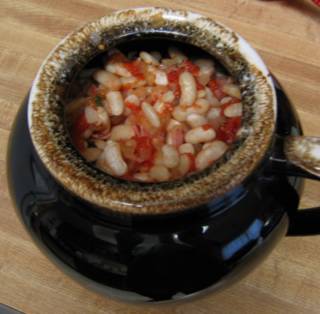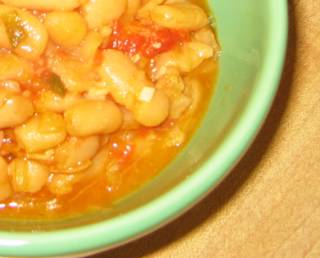
promising beginnings
My grocery store carries canning supplies for a limited time each year and I shopped for pectin a little late this year. Consequently, supplies were low and I was forced to buy a different brand than I normally use. I compared the two brands’ recipes for apricot jam and the ingredients and amounts were the same for both, so I didn’t worry about it much.
I like to cut the apricots in eighths and then pulse them a few times in the food processor. Cutting them in pieces this size first is quick to do and allows the food processor to cut them fairly uniformly. You still get a few nice chunks in there, but they won’t be too big.

unpeeled apricots, pitted and cut in eighths
You need to stir the fruit and pectin mixture continuously until it boils and then add the sugar and continue stirring until it returns to a boil. This takes a little while. While you’re stirring this steaming mixture, there’s a huge vat of boiling water waiting for your jars of jam and a smaller pot with the lids simmering on a back burner. Thank goodness for air conditioning!

trouble brewing
When the apricot mixture was ready I had quite a bit of foam, so I started to try to remove some of it before ladling the jam into the jars. Before too long I realized the entire mixture was pretty much just foam. I gave up on the idea of removing it, and just went ahead and put it into the jars, and processed them in the canner for 10 minutes. It’s the strangest looking jam I’ve ever seen. Not only is it all foamy, but some of the jars (the ones that were ladled out first, I think) separated! It was really very discouraging.

this year's ugly jam - notice the separation
I puzzled over this for quite a while – what was different this year? Of course, the first thing that came to mind was that I had used a different brand of pectin. I haven’t ruled that out, but I have trouble believing that is the reason. Then I vaguely recalled that I added a small amount of butter to the fruit mixture in past years. I couldn’t remember if this was a suggestion I had read somewhere or if it was in the instructions for my regular brand of pectin. I checked the old instructions and sure enough, they say that you can add ½ teaspoon of butter to the fruit and pectin mixture to reduce foaming if desired. So I guess that ½ teaspoon of butter makes a big difference. Can anybody think of any other reason the jam might have foamed so badly?

beauty and the beast - this year's jam is on the left, last year's is on the right

















